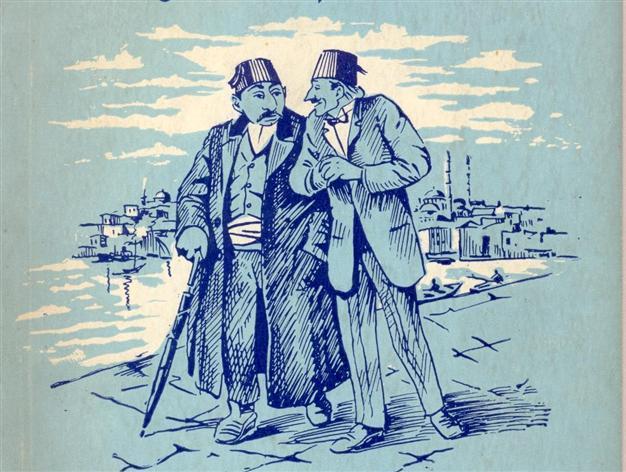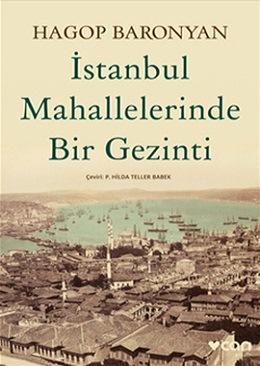An Armenian stroll through 19th century Istanbul
William ARMSTRONG - william.armstrong@hdn.com.tr
 'Istanbul Mahallelerinde Bir Gezinti’ (A Trip through Istanbul’s Neighborhoods) by Hagop Baronyan, trans. P. Hilda Teller Babek (Can Yayınları, 12.50TL, 136 pages)
'Istanbul Mahallelerinde Bir Gezinti’ (A Trip through Istanbul’s Neighborhoods) by Hagop Baronyan, trans. P. Hilda Teller Babek (Can Yayınları, 12.50TL, 136 pages)The irreverent tone of Hagop Baronyan’s tour of 19th century Istanbul is set in the first paragraph of the first chapter, describing the village of Ortaköy on the European shore of the Bosphorus: “If you want to enter Ortaköy from the road alongside the pier,” he writes, “you can immediately smell six different wonderful toilet scents. For the locals, a sensitive nose is a big problem.” Baronyan was an Ottoman Armenian born in Edirne in 1842, who moved to Istanbul in 1864. He lived by the pen, writing satirical portraits of social life and pieces for the theater, before dying a very 19th century death from tuberculosis after struggling penniless on the streets of the city. He is now widely seen as the greatest Armenian satirist of all time, but this volume was only translated into Turkish and published last month.

Baronyan writes so vividly that the reader can see the sights and smell the toilets of each neighborhood he visits. As a master satirist, he floats about uncommitted, drily pointing out peculiarities and making sweeping generalizations everywhere he goes: The Armenians of Hasköy are disloyal; those in Rumelihisarı are heavy drinkers and indiscreet; those in Ortaköy are vain and pretentious; the denizens of Kuzguncuk are even-tempered and relaxed. Eyüp was just as conservative as today and Baronyan takes a dim view of the lack of rakı available there: “Here, there is neither friendship nor youth. But there is selfish and ignorance.” Beyoğlu is reliably described as “Istanbul’s Paris,” though only “if Paris doesn’t feel too degraded to be associated with Beyoğlu.”
Some of the epigrammatic chapters read as mini-short stories, others are imaginary, sketch-like dialogues with local fishermen. Almost every paragraph is laced with irony, but at times literary whimsy takes Baronyan away. In Eyüp, for example, he tells us that the locals are known for having a lot of dreams while sleeping: “They see so many dreams that there aren’t any left for the rest of us.” He also uses a couple of sentences of each chapter to address the weather of each place. But although these conditions are surprisingly varied, it’s a general rule that “however bad the weather, it is always better than the schools.”
The two main institutions organizing Armenian neighborhoods were the schools and the churches. The elected church administrators were responsible for organizing funds for schools and other social amenities, and Baronyan spends much of his time mirthfully observing their endless disagreements. Equally important, however, are the taverns (meyhanes), which he drolly suggests are “not as difficult to keep alive as it is to keep open a school.” His focus is on the rich variety of social life, and he generally avoids lofty political speculation. “Don’t ask about politics,” he writes about the residents of Topkapı. “They’re not interested. If the names of Gladstone, Beaconsfield or Grandville escape your mouth, people will think it’s a French swear word and give you a slap.” It’s a revelation to discover such a jocular street-level guide to 19th century Armenian Istanbul, and I’m sure there’s an audience for this kind of Sultan-less Ottoman literature that English-language publishers have yet to clock onto.
There’s a Dickensian quality to Baronyan’s sketches. Of course they are exaggerated, but it’s somber to remember just how colorful and distinct each part of the city once was, when even the toilet smells in each neighborhood were distinct. You can still get a whiff of that difference in parts of Istanbul today, but often the most remarkable thing about the city’s various neighborhoods are the giant new shopping malls going up and the new highways being laid down.
 'Istanbul Mahallelerinde Bir Gezinti’ (A Trip through Istanbul’s Neighborhoods) by Hagop Baronyan, trans. P. Hilda Teller Babek (Can Yayınları, 12.50TL, 136 pages)
'Istanbul Mahallelerinde Bir Gezinti’ (A Trip through Istanbul’s Neighborhoods) by Hagop Baronyan, trans. P. Hilda Teller Babek (Can Yayınları, 12.50TL, 136 pages) Baronyan writes so vividly that the reader can see the sights and smell the toilets of each neighborhood he visits. As a master satirist, he floats about uncommitted, drily pointing out peculiarities and making sweeping generalizations everywhere he goes: The Armenians of Hasköy are disloyal; those in Rumelihisarı are heavy drinkers and indiscreet; those in Ortaköy are vain and pretentious; the denizens of Kuzguncuk are even-tempered and relaxed. Eyüp was just as conservative as today and Baronyan takes a dim view of the lack of rakı available there: “Here, there is neither friendship nor youth. But there is selfish and ignorance.” Beyoğlu is reliably described as “Istanbul’s Paris,” though only “if Paris doesn’t feel too degraded to be associated with Beyoğlu.”
Baronyan writes so vividly that the reader can see the sights and smell the toilets of each neighborhood he visits. As a master satirist, he floats about uncommitted, drily pointing out peculiarities and making sweeping generalizations everywhere he goes: The Armenians of Hasköy are disloyal; those in Rumelihisarı are heavy drinkers and indiscreet; those in Ortaköy are vain and pretentious; the denizens of Kuzguncuk are even-tempered and relaxed. Eyüp was just as conservative as today and Baronyan takes a dim view of the lack of rakı available there: “Here, there is neither friendship nor youth. But there is selfish and ignorance.” Beyoğlu is reliably described as “Istanbul’s Paris,” though only “if Paris doesn’t feel too degraded to be associated with Beyoğlu.”